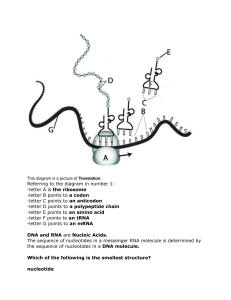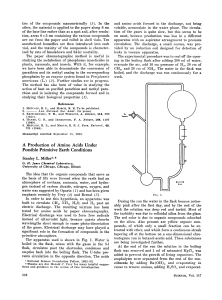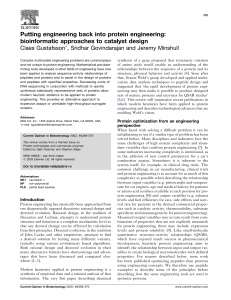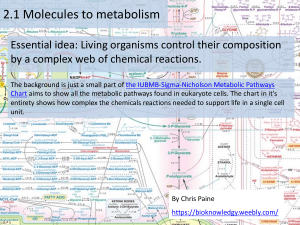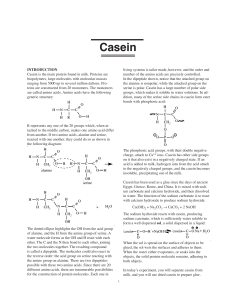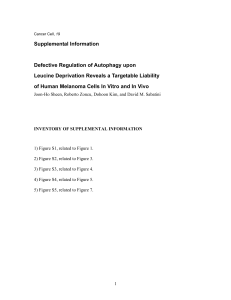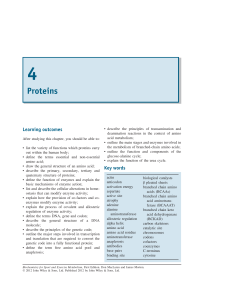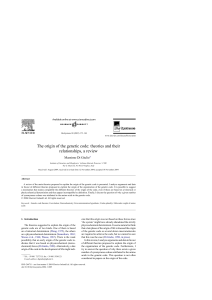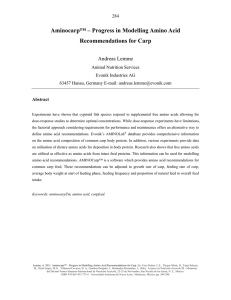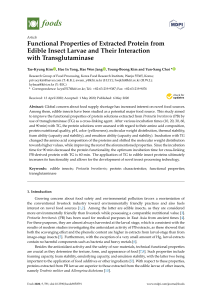Código genético Comparing proteins with nuclei acid: What do
Anuncio
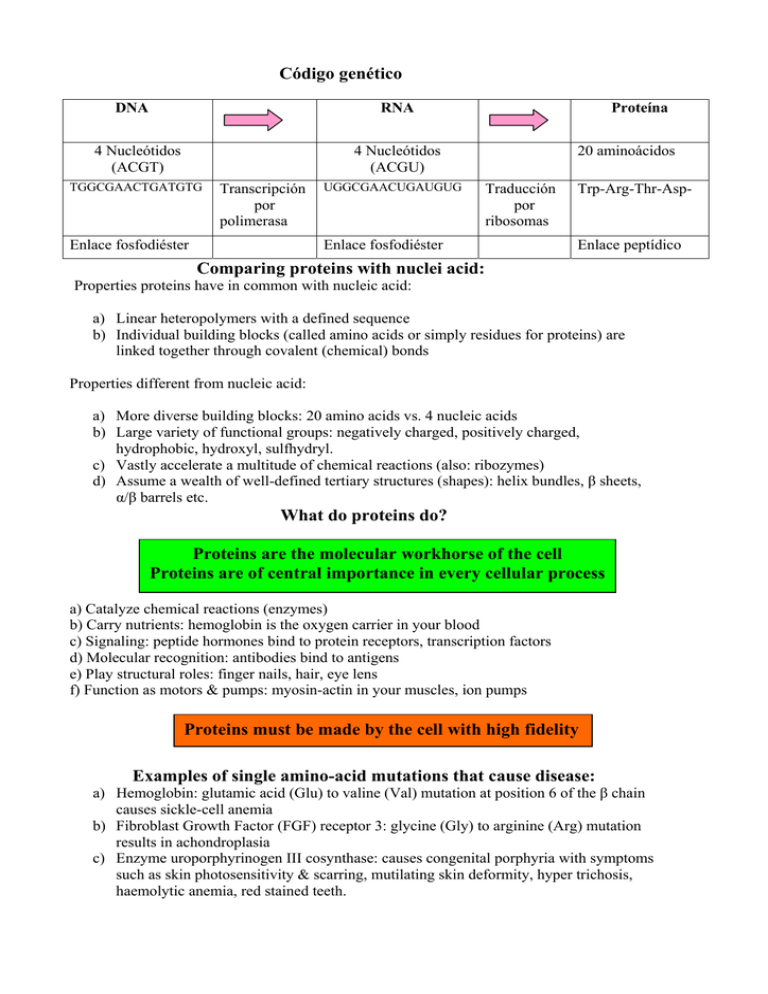
Código genético DNA RNA 4 Nucleótidos (ACGT) Proteína 4 Nucleótidos (ACGU) TGGCGAACTGATGTG Transcripción por polimerasa Enlace fosfodiéster UGGCGAACUGAUGUG 20 aminoácidos Traducción por ribosomas Enlace fosfodiéster Trp-Arg-Thr-Asp- Enlace peptídico Comparing proteins with nuclei acid: Properties proteins have in common with nucleic acid: a) Linear heteropolymers with a defined sequence b) Individual building blocks (called amino acids or simply residues for proteins) are linked together through covalent (chemical) bonds Properties different from nucleic acid: a) More diverse building blocks: 20 amino acids vs. 4 nucleic acids b) Large variety of functional groups: negatively charged, positively charged, hydrophobic, hydroxyl, sulfhydryl. c) Vastly accelerate a multitude of chemical reactions (also: ribozymes) d) Assume a wealth of well-defined tertiary structures (shapes): helix bundles, β sheets, α/β barrels etc. What do proteins do? Proteins are the molecular workhorse of the cell Proteins are of central importance in every cellular process a) Catalyze chemical reactions (enzymes) b) Carry nutrients: hemoglobin is the oxygen carrier in your blood c) Signaling: peptide hormones bind to protein receptors, transcription factors d) Molecular recognition: antibodies bind to antigens e) Play structural roles: finger nails, hair, eye lens f) Function as motors & pumps: myosin-actin in your muscles, ion pumps Proteins must be made by the cell with high fidelity Examples of single amino-acid mutations that cause disease: a) Hemoglobin: glutamic acid (Glu) to valine (Val) mutation at position 6 of the β chain causes sickle-cell anemia b) Fibroblast Growth Factor (FGF) receptor 3: glycine (Gly) to arginine (Arg) mutation results in achondroplasia c) Enzyme uroporphyrinogen III cosynthase: causes congenital porphyria with symptoms such as skin photosensitivity & scarring, mutilating skin deformity, hyper trichosis, haemolytic anemia, red stained teeth. Translation The first step in following the blueprint of DNA to make a protein is transcription which generates an mRNA copy from the DNA template Translation is the 2nd step: it uses the mRNA template to make the protein polymer. This process is also called protein synthesis The reasons for having two steps instead of one are: Amplification: a single copy gene on DNA can be transcribed into many copies of mRNA Increased levels of control: regulation of transcription as well as translation Ability to separate the mechanism for DNA replication & transcription from protein synthesis In eukaryotes: Ability to spatially separate replication & transcription (nucleus) from protein synthesis (cytoplasm) Translation is the process of reading the copy of genetic information on the mRNA (linear sequence of 4 different nucleotides) and translating it into the proper linear protein sequence of 20 different amino acids This process is performed in one of the most complex organelles of the cell, the ribosome. In the ribosome the mRNA sequence (information) is read and the corresponding polypeptide (protein) is assembled. The rules for translating the linear nucleic acid sequence (mRNA) into the linear amino acid sequence (protein) are called the genetic code How to encode a 20-letter alphabet (protein) with a 4-letter alphabet (DNA)? 1 Nucleotide 2 Nucleotides 3 Nucleotides 4 A,C,G,U 4 amino acids 4 x 4 = 16 AU, AG, CA, UU, etc. 16 amino acids 4 x 4 x 4 = 64 AUG, UGC, CGA, etc. 64 amino acids Since two nucleotides are not enough (16), three nucleotides are hended to code for all 20 amino acids. Thus Crick proposed that codon triplets code for individual amino acids There are several possibilities how triplets might code for amino acids: To verify that the code uses triplets and to determine: Overlapping vs. non-overlapping code Punctuated vs. unpunctuated code The redundancy of the code (64 triplets for 20 amino acids) The following experiments were performed in the early 60s. Crick & Brenner (1961) showed the effect of successive deletions of nucleotides in bacteriophage T4 DNA. ATG Met ATG Met ATG Met ATG Met CTG Leu CTC Leu CTT Pro CTC Leu CTC Leu TCT Ser CTG Leu TGT Cys TGT Cys GTG Val TGC Cys GCC Ala GCC Ala CCG Pro CGC Arg GCC Ala GCC Ala CC . Pro C. . . . . . . . . . . Original sequence 1 nucleotide deleted 2 nucleotides deleted 3 nucleotides deleted 1-Deletion of 1 or 2 nucleotides (frame shift mutation) results in non-functional protein 2-Deletion of 3 nucleotides results only in deletion of 1 amino acid 3-Insertion of 3 nucleotides results in insertion of 1 amino acid 4-Change of 1 nucleotide results in either a sense or silent mutation or in a missense mutation Nucleotides are read as triplets without overlap or punctuation Deciphering the Genetic Code Which triplet codon corresponds to which amino acid? Síntesis proteica en un sistema libre de células detenida a los pocos minutos después de la adición de desoxirribonucleasa y continuada por la adición de mRNA. La polinucleótido fosforilasa forma polímeros del tipo RNA aleatorios En 1955 Marianne Grunberg-Manago y Severo Ochoa descubrieron el enzima bacteriano polinucleótido fosforilasa, que cataliza in vitro la reacción In vitro (RNA)n + ribonucleósido difosfato In vivo (RNA)n + 1 + Pi El enzima requiere los 5’difosfatos de los ribonucleótidos y no esta dirigída por un molde. El polimero de RNA formado no tiene una secuencia de baser específica. La reacción transcurre tanto con un sólo nucleósido difosfato como con los cuatro. “La composición de bases del polímero sintetizado por el enzima refleja las concentraciones relativas de los sustratos 5’-difosfato en el medio”. Nirenberg (1961) added synthetic homo-polynucleotides to bacterial lysate: Poly U Poly A Poly C UUUUUUUUUU. Phe-Phe-Phe-Phe-. AAAAAAAAAA. Lys-Lys-Lys-Lys-. CCCCCCCCCCC. Pro-Pro-Pro-Pro-. Thus the first codon was determined: UUU codes for phenylalanine; alternatively, AAA code for lysine and CCC for proline. Mixed Copolymers Allowed Additional Codon Assgnments Codon Assignments from repeating copolimers (Khorana) Using a combination of organic synthesis and copying by DNA polymerase I, double-stranded DNA with simple repeating sequences can be generated. RNA polymerase will then synthesize long polyribonucleotides corresponding to one or the other DNA strand, depending on the choice of ribonucleoside triphosphates added to the reaction mixture. Assignment of Codons Using Repeating Copolymers Built from Two or Three Nucleotides * Con estos polinucleótidos los patrones de incorporación de aminoácidos en polipéptidos están afectados por la presencia de codones que son señales de terminación para la biosíntesis de proteínas . En las secuencias repetitivas de tres nucleótidos, uno de los tres marcos de lectura sólo incluye codones de terminación y, por tanto, sólo se observan dos homopolipéptidos. En algunas de las secuencias repetitivas de cuatro nucleótidos, cada cuarto codón es una señal de parada en cada marco de lectura; por tanto, sólo se producen péptidos cortos. In 1964 Nirenberg & Leder developed a filter-binding assay: 1) Midiendo la unión codón –dependiente de moléculas específicas de tRNA a los ribosomas. 2) Utilizando como moldes poirribonucleótidos sintéticos con una secuencia ordenada. Los trinucleótidos promueven el acoplamiento de moléculas específicas de tRNA a los ribosomas. Código genético In 1968 Nirenberg & Khorana jointly were awarded the Nobel Prize for the elucidation of the Genetic Code. Features of the Genetic Code a) The Code transfers information from mRNA to proteins with high fidelity b) It is redundant or degenerate: 61 mRNA triplets code for 20 amino acids c) Most codons for a given amino acid differ only in the last (third) base of the triplet (exeptions. Leu, Arg y Ser) d) One codon (AUG or GUG, UUG and AUU) also signals the START of a plypeptide chain e) Three codons (UAA, UAG and UGA) are used to signal the END of a polypeptide chain (STOP codons) f) The universality of the Genetic Code is a result of strong evolutionary pressure: a change in a single codon would alter nearly every protein made by an organism g) The universality is the basis for recombinant protein technology: mammalian mRNA sequences inserted into bacteria will be correctly expressed (translated)
